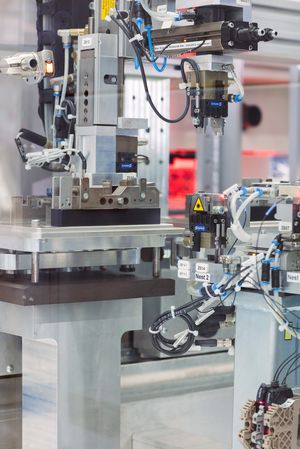KANBrief 4/17

In the factory of the future, human beings and machines will be linked together by data networks. The "things" and systems will also communicate with each other: workpiece with tool, market with production, production with upstream supplier. However, networking of this kind within production processes and across company boundaries is possible only if standards and specifications are in place that apply throughout the world – and if a well qualified workforce is available.
Siemens' workers at the company's electronics plant in Amberg have been manufacturing the Simatic programmable logic controller since 1989. The Simatic, available in over 1,000 variants, can be used to control virtually anything, from a theatre curtain to a conveyor belt in a car factory. Furthermore, in Amberg, each Simatic organizes its own manufacturing process. This is made possible by a unique product code on each printed circuit board (PCB). Through this code, the PCB instructs each machine regarding its requirements and the next production steps. All processes are optimized and controlled by IT, and everything is networked with everything else via the Industrial Internet of Things (IIoT) and the company's own cloud solution. Over a thousand scanners document each and every step within the manufacturing process in real time, gathering information such as soldering temperature, pick and place data and test results. Each part, each machine and each work step is converted into data and recorded.
As a result, over 50 million data records are produced every day: big data. The data are evaluated in real time and production is analysed comprehensively. In this process, the sensors and data flows form an artificial neural network: based upon the data, the smart factory determines for example what product is to be manufactured and when. At the same time, the latest developments of Simatic are continually being implemented in the production process, and the observations made during production fed back to the research & development departments.
Data from warehouses and suppliers in the USA, China and Germany also influence production in Amberg. This would not be possible if standards and specifications for suitable interfaces and reliable communication did not exist. Owing to the wealth of affected areas of technology, an all-encompassing Industry 4.0 standard will probably not arise. The German Industry 4.0 platform has however developed the RAMI 4.0 reference architecture model, and the US Industrial Internet Consortium (IIC) the Industrial Internet Reference Architecture (IIRA). Siemens is among the companies actively involved in both organizations, which are now cooperating with each other.
Despite the far-reaching trend of digitalization, the Siemens plant looks much the same as it did when it was opened, apart from the machines being larger and there being more of them. The plant has however increased its production volume by a factor of nine, with no change in footprint and hardly any increase in the size of the workforce. Quality also witnessed a major leap forward. Whereas in 1989, the defect quota was 500 per million possible defects (dpm), it is now lower than 11 dpm.
Rather than always completing the same task at the same point in the production process, each worker now switches between a number of workstations. Instead of just one product, they can now produce up to 100 different products in the modern production cells. The workers are assisted by monitors displaying the required information. And whilst robots assume the highly repetitive and therefore monotonous tasks, human beings monitor the production and testing processes. They also develop ideas for improvement, and intervene when unanticipated incidents occur.
The workforce's depth of knowledge consequently changes in two directions: on the one hand, experts must now know their machines intimately and be capable of using the powerful software; on the other, the systems enable the workforce to operate the machines much more effectively and to optimize them. Studies exist (Pfeiffer; Lee; Zirnig; Suphan (2017): Industrie 4.0 – Qualifikation 2025; Pfeiffer; Suphan (2015): Der AV-Index. Lebendiges Arbeitsvermögen und Erfahrung als Ressourcen auf dem Weg zu Industrie 4.0; Jung, Kleibrink, Köster, Lichter, Rürup (2016): Eine Wachstumsstrategie für das digitale Zeitalter. Handelsblatt Research Institute.) showing that Germany's well trained and skilled workforce is able to meet these requirements better and more quickly than its counterparts in many other countries. Together with Germany's leading position in technology, this should safeguard the country's attractiveness as an industrial location. Whether this desired scenario comes about, and whether adequate consideration will at the same time be given to the interests of employees, remains to be seen.
Petra Hannen, freelance author
mail@petrahannen.de